Khewra – The Salt Mines
April 21, 2006

The salt mine of Khewra
Salt mines? For Indonesians, the concept of salt mines may be difficult to accept, as in our country the salt is produced through the drainage of sea water. But in Pakistan, it does exist the world’s second biggest salt mine on earth (the first one is in Poland). Yes, the salt is produced from the caves in the salt hills in the heart of Punjab.
That was the reason led me to Chakwal, the northern gate to the salt range, not far from Rawalpindi. The town itself is not inspiring. Not far from Chakwal, there is ancient Hindu pilgrimage in Katas.
Katas can be reached by public buses from Chakwal to Choa Shaden Shah (the name of this town is also interesting, as Choa in Urdu does mean ‘rat’), 25 km to southeast, continued by an easy five kilometre ride to Katas. Katas, once a very important Hindu pilgrimage, now is quite desarted after the partition of India-Pakistan, as almost no Hindus left in this area.
The legend said that the holy pool in Katas was formed by one of the two teardrops of Shiva Mahadev. The other teardrop had formed the holy pool in Pushkar, near Ajmer Sharif. I have visited the site in Pushkar previously, where Hindu pilgrims made their important holy pilgrimage to take a dip into the holy water. The town of Pushkar itself was too holy, that even blood, meat, and eggs are forbidden food in the whole area.
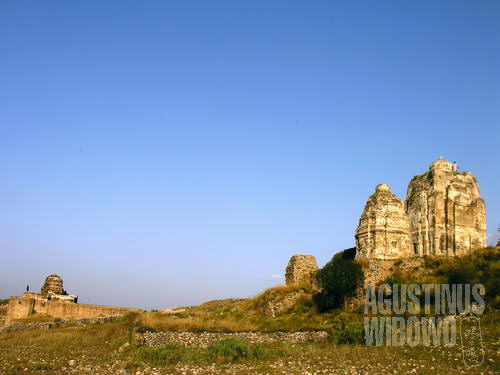
Deserted Hindu temple
The Hindu temple in Katas, sadly, quite deserted. As the Hindus around the area had left the site to the Indian site, practically almost no Hindus left. The temple became a favorite tourist site for people around the area. Some parts of the temple had turned to be ruins, and some tourists creatively put their signatures and grafittis on the remaining walls. The pool became swimming pool for the local young boys. Only some time, the real Hindu pilgrims, after succeeded with their Pakistan visa struggle, make their way to here.
Further down from Choa Shaden Shah, is the famous salt mines of Khewra. Only recently that this site opened to visitors. In previous years, a prior permission should be made before visiting the area. Now, as it’s a tourist spot (even not so popular), there is an entrance ticket system, and foreigners have to pay 6$ while locals pay 40 Rupees (less than 1$). I succeeded to bargain it down to 3$. There were many bus groups from Punjab University, as it seems that Khewra had become a favorite excursion spots for the undergraduate students. The ticket price included a guide, who will be responsible that nobody is leaving the group and go to inappropriate places. I joined a group from the university, whose leader (teacher) speaks very good Malay language (he got his degree after 6 years in Malaysia).
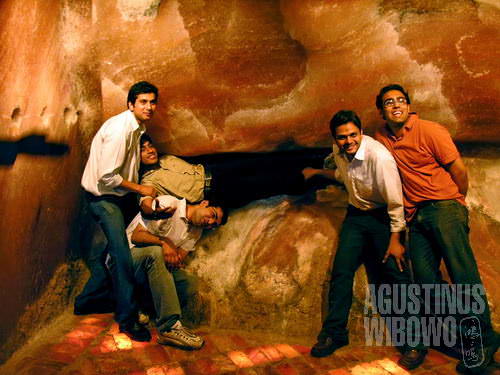
Having fun with salt
The entrance to the salt mines is a cave with railway track on it. The train was not operating for tourists actually. And the track goes deep through the cave. This is a cave of salt. The wall, the roof, the floor, everything is salt. The temperature inside is a cool 18 degree, no matter of seasons. There are 17 floors of mines in this cave, but visitors are only allowed to see one.
The salt is mined from the wall, but once the mining had reached the limit, that is said water flowing out, then the site should be given up, and the mining should move somewhere else. The gorges and rivers formed by the mining became very deep and dark. I imagined if I jumped inside, maybe the sound produced by the water would come a minute later.
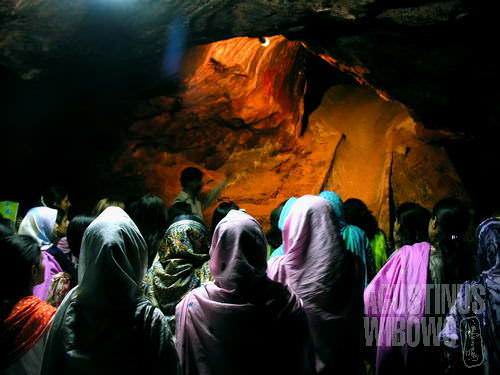
Female university students listen to guide explanation of the salt mines
As it has became a tourist site, more and more attractions were built inside the caves. The ambition was to build a city inside this salt caves, and the materials are of course only salt. They have built a hospital, a post office, a mosque (cant be neglected here), canteen, and now in progress: Minar e Pakistan (the tower of Pakistan). Everything can be built from salt, and it’s concrete. These buildings of salt bricks, coloured by red lamps inside the construction, did really remind me to those ice brick building in Harbin (China) ice festival. Looks similar, but unlike ice buildings, salt doesnt melt in several months.
The salt mining had been done since the era of Alexander the Great. The Mughal kings also continued the world. But the modern techniques were just used recently, under support of Polish engineers, from the country where the biggest salt mines on earth are located. Despite of that, the mining is even less than 1% of the total salt in the area of salt range.
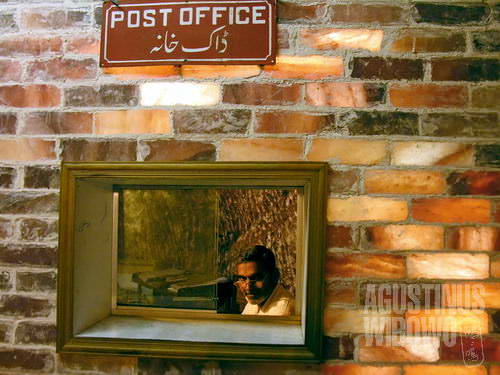
Salty post office
The salt area also caused some problems. The motorway passing the area, connecting Rawalpindi to Lahore, supposed to be high speed way with average speed of 120km/h, forces all vehicles to crawl at 50km/h. I havent learnt yet what the reason behind this slow speed rule, but I bet that the salt range is too fragile to be passed by cars flying with high speed.
The guys from the Punjab University were so kind hearted to try to persuade the teachers to allow me to go with their bus to Lahore (I am going to Lahore anyway). But my luggage were still in Chakwal, 50 kms away from here. So they tried to take me to the closest bus stop. In fact, that there were no exact plans, and I found myself having lunch together with the group of male and female students (separate buses of course for the female students, due to the law of sexual seggregration) in a place that even further from my initial direction. Talking about sexual seggregation, the teacher who had spent years in Malaysia said that he felt sinful to sit next to women in buses in Malaysia, that after the study he made his pilgrimage to Mecca to clean his sins (of sitting next to women in public buses…)
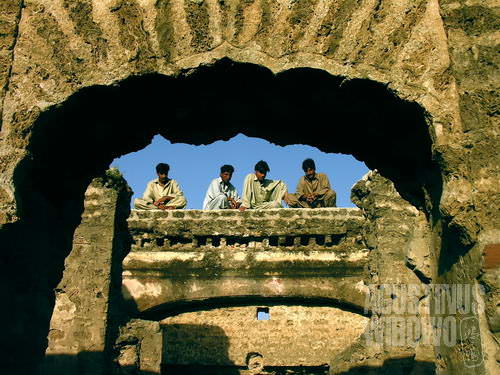
Remnants of once a holy site of the Hindus

The holy pool now becomes a playground
Very late in the night, I made my way to Lahore by a public bus (quite expensive as 180 Rs). Again in the bus, I saw unusual (now became usual for me) way of Pakistani jokes: two young boys kissing each other, one guy asked the other to marry him, but the other said that he had a girlfriend already (I doubted it). Umer (20)and Hamzah (18), the names of these two boys, then asked me to forget what I had seen, as it was just merely joke. I know it was joke, and this unusual joke have been usual for me already (Lam Li said that Pakistan had changed me a lot, and I had to re-consider my sexual orientation ![]() )
)






Halo mas, betah bener lu disana terus. Buset deh…btw, gua lagi di Hangguo, menikmati kota metropolitan. Sesudah beberapa bulan di penjara di hutan. Kurang fotogenic nih disini, soalnya kena badai debu dari zhongguo. Yuk ah!
Alo,besok saya mo wisata ke Salt Mines..tadi iseng search di internet dan nemu blog ini deh 🙂 Infonya padat juga.. Ohya sampe lupa, saya sudah sebulan di Lahore, belum banyak berkunjung, baru ke lahore zoo, musium,dan waghna border. Kebetulan saya lagi summer school di NUCES dan ini baru kali pertama saya ke pakistan.. Btw, suka travelling ya? 🙂